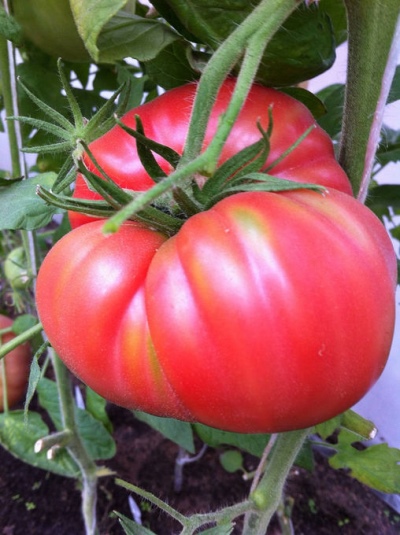
- Authors: USA
- Name synonyms: Church, Temple, Church
- Category: grade
- Growth type: indeterminate
- Appointment: fresh consumption, for juice, for ketchup and tomato paste
- Ripening period: mid-season
- Growing conditions: for greenhouses
- Bush size: tall
- Bush height, cm: 200
- Bush characteristic: powerful
The Church got its name due to the non-standard shape of the fruits, which resemble church domes. The special characteristics of the fruit crop at a high level were noted by many gardeners. Today the tomato Church has taken root in many regions of the country. There is evidence that the cultivation of this variety began more than a century ago. If earlier monks were engaged in its cultivation, now it is chosen by experienced gardeners and beginners.
Description of the variety
The variety has an indeterminate type of growth. Bushes of the Tserkov variety are tall, reaching a height of 2 m. Under certain conditions, they can grow up to 3 m. These are powerful plants that take up a lot of space on the site. The shoots are covered with leaves of the usual type. The plant mass is dense, saturated green.
Growers advise growing this variety in greenhouses to achieve maximum fruiting and keep the bushes healthy. Ripe fruits are widely used. Tomatoes are used to prepare delicious tomato paste, ketchup or juice. In their natural form, they are also widely used.
The main qualities of the fruit
Upon reaching maturity, the tomatoes acquire a bright pink color. A unique feature of the variety is the large size of the vegetables. Their average weight ranges from 400 g to 1 kg. Experienced vegetable growers have ways to grow real champions who are gaining weight up to 2.5 kg.
The shape of the fruit is flat-round. In the area where the tomatoes are attached to the stalk, a small depression is noticeable. Also, the vegetables are covered with expressive edges, thanks to which they become as close as possible to church domes. This feature is most often observed in fruits in the lower part of the bush.
The pulp is sugary and fleshy. When fully ripe, the peel becomes dull. The structure of tomatoes can be different. Some grow dense, others softer and looser, but vegetables are never watery. Few seed nests with a small number of seeds are formed inside.
Taste characteristics
The taste of vegetables is excellent. The fruits grow sweet and aromatic, with a pleasant and pronounced aftertaste. The gastronomic characteristics vary depending on the region where the tomatoes are grown. Excellent taste increases the interest of gardeners in this variety. Even fully ripe tomatoes can be stored for a long time without losing taste, appearance and other characteristics.
Ripening and fruiting
The Church variety is considered mid-season. In regions with a warm climate, vegetables are harvested earlier than in the central and northern regions.
Yield
A high-yielding fruit crop allows you to get a stable harvest while observing standard agricultural practices. Up to 5 kg of fruits are harvested from one bush per season.
The timing of planting seedlings and planting in the ground
Seedlings are transplanted only after they are 50 to 60 days old. With this in mind, the exact timing of sowing the seeds can be calculated. It is not recommended to plant seed before the scheduled date, otherwise the plant will get used to new weather conditions for a long time. Yields will also suffer. The number of ovaries decreases, tomatoes lose their brightness, juiciness and taste characteristics.

Growing tomato seedlings is an extremely important process, because it largely depends on whether the gardener will be able to harvest at all. All aspects must be taken into account, from seedbed preparation to planting in the ground.
Landing scheme
The maximum planting density should not exceed 3 plants per 1 sq. m of territory. An overly dense planting often causes the appearance and spread of fungal diseases. If tomatoes grow too close to each other, you will not be able to achieve excellent yields.

Growing and care
When growing the variety Church, it is imperative to perform some activities.
- Tall bushes need tying up. The supports are placed before the plants are planted in the ground. The garter is carried out as they grow.
- Pinching is carried out regularly. Removing unnecessary shoots is necessary so that forces and nutrients are spent on the formation of fruits, and not plant mass.
- Shrub formation is also necessary. Most often, the option of forming in 2 stems is chosen. It is convenient to harvest and care for the plantation.
Also, the beds need the following care:
- watering with warm, settled water;
- cleaning the plantation from weeds;
- removal of dry leaves and damaged shoots;
- airing the greenhouse;
- loosening the upper layers of the soil;
- the use of dressings in certain phases of growth.
Note: some growers believe that the bushes can be transplanted into open ground due to their resistance to low temperatures.




A plant needs different micronutrients at each stage of growth. All fertilizers can be divided into two groups: mineral and organic. Folk remedies are often used: iodine, yeast, bird droppings, eggshells.
It is important to observe the rate and period of feeding. This also applies to folk remedies and organic fertilizers.



























































































